Overview
Navigating the Social Security Disability Insurance (SSDI) filing process can feel overwhelming. We understand that many face challenges when seeking the support they need. That’s why we’ve outlined five essential steps to help you through this journey.
- First, it’s crucial to determine your eligibility. Knowing if you qualify can save you time and effort.
- Next, gathering the necessary documentation is vital. This includes medical records and any other relevant information that supports your claim.
- Once you have your documents, accurately completing the application is key. Take your time with this step; it can make a significant difference in your approval chances.
- Understanding the SSA review process is also important. Familiarizing yourself with what to expect can ease some of the anxiety.
- If your application is denied, don’t lose hope. Navigating the appeals process is your next step, and many have successfully turned their situations around.
Remember, thorough preparation is essential, and you’re not alone in this. Organizations like Turnout offer non-legal advocacy assistance to guide you.
We’re here to help you every step of the way. With the right preparation and support, you can improve your chances of success. You deserve the assistance you need, and we believe in your journey.
Introduction
Navigating the Social Security Disability Insurance (SSDI) filing process can often feel like traversing a complex maze. We understand that the many eligibility criteria and documentation requirements can be overwhelming. For those seeking financial support during challenging times, knowing the steps to successfully file for SSDI is crucial.
However, with approval rates declining and proposed changes on the horizon, it’s common to feel uncertain. How can you effectively prepare for this intricate process and enhance your chances of a successful claim?
You're not alone in this journey. We're here to help you understand the path ahead.
Determine Your Eligibility for SSDI
Determining your eligibility for SSDI filing can feel overwhelming, but we're here to help you navigate this process. To qualify, you need to meet several important criteria:
-
Work Credits: Generally, you need to have earned 40 work credits, with 20 of those credits earned in the last 10 years. Work credits are based on your total annual wages or self-employment income. It’s worth noting that approximately 80 percent of disabled workers are aged 50 or older. Understanding work credit requirements is crucial, especially as they relate to age.
-
Disability Definition: You must have a medical condition that meets the Social Security Administration's (SSA) definition of disability. This means your condition must prevent you from engaging in substantial gainful activity (SGA) for at least 12 months. Recent proposals could decrease disability benefits eligibility by as much as 20 percent, so it’s essential to ensure your condition aligns with SSA standards.
-
Medical Evidence: Your condition needs to be documented by medical evidence, including records from healthcare providers detailing your diagnosis and treatment. The SSA requires comprehensive documentation to support your claim. Keep in mind that the approval rate for claims has recently declined, averaging only 36 percent.
-
Age Considerations: If you’re under 24, the requirements may differ slightly, as you may not need as many work credits. However, proposed changes could disproportionately affect older applicants, particularly those over 50, who may face stricter eligibility assessments.
To check your eligibility, consider using the SSA's online tools or consulting with a knowledgeable advocate from Turnout. They are trained nonlawyers who can guide you through the process. Remember, Turnout is not a legal practice and does not offer legal guidance; rather, they employ trained non-legal advocates to assist with SSDI filing. This support can be invaluable as you navigate the complexities of the Social Security disability landscape.
Staying updated on the changing disability support landscape is crucial, especially with potential modifications that may impact hundreds of thousands of applicants. You are not alone in this journey, and there are resources available to help you every step of the way.
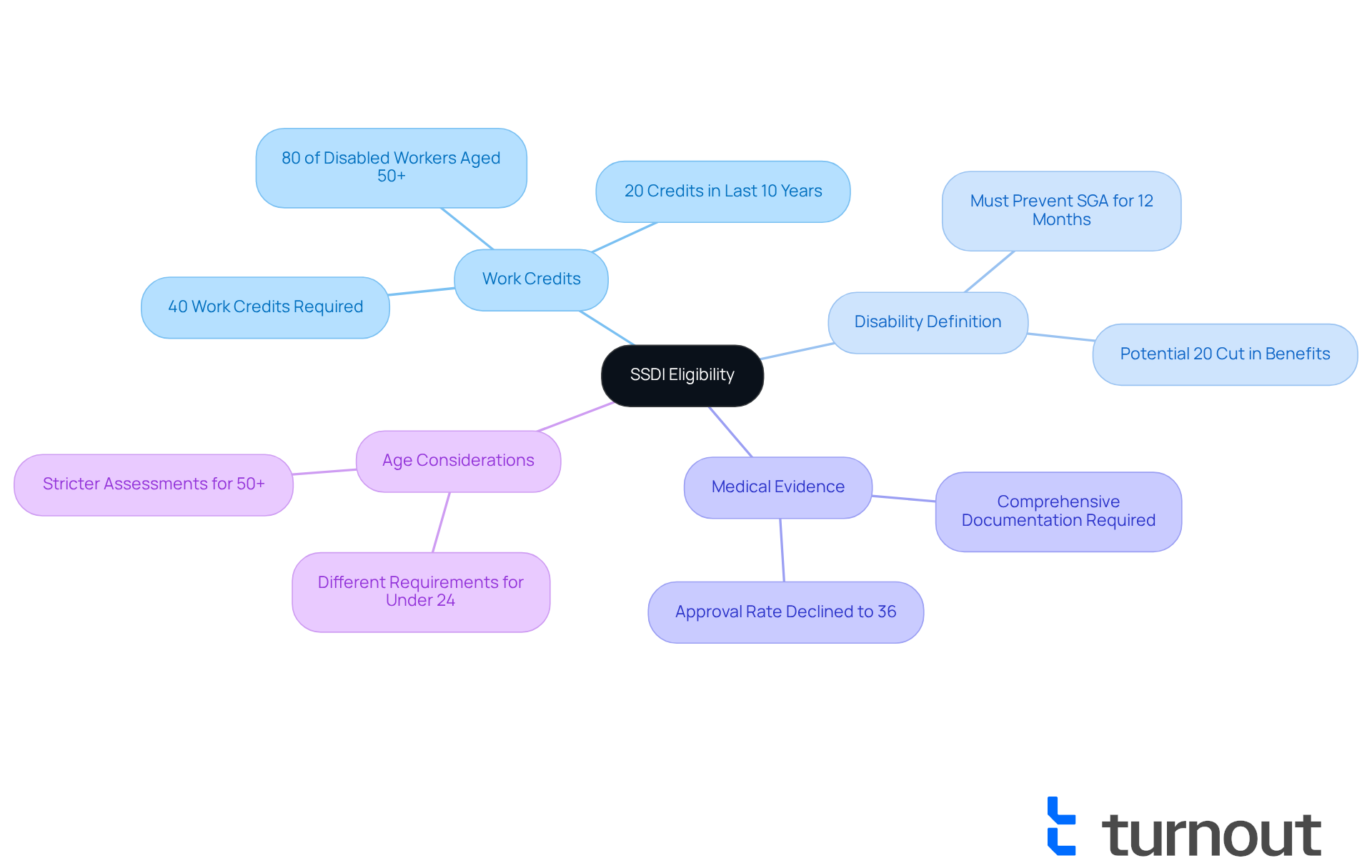
Gather Necessary Documentation for Your Application
Collecting the required documentation is a crucial stage in the SSDI filing process. We understand that this process can feel overwhelming, but we’re here to help. Here’s what you need:
- Personal Information: Make sure to include your Social Security number, birth certificate, and proof of U.S. citizenship or lawful alien status.
- Medical Records: Obtain detailed medical records from your healthcare providers. This includes diagnoses, treatment history, test results, and doctor's notes on daily activity limitations that support your claim. Regular healthcare visits can increase the amount of medical evidence, strengthening your case.
- Work History: Prepare a list of your jobs for the past 15 years. Include the names of employers, job titles, and dates of employment. You may also need W-2 forms or pay stubs to verify your earnings.
- Disability Reports: Complete the Adult Disability Report (Form SSA-3368) and any other relevant forms. These should detail how your disability affects your daily life. Clear evidence of how your condition limits your ability to work is essential, as the SSA doesn’t automatically understand your job duties based on your job title alone.
- Additional Evidence: Collect any other documents that may support your claim. This could include statements from family or friends about how your condition impacts your ability to work. A written statement from your doctor outlining your condition and its restrictions can be an excellent strategy to enhance your case.
We know that navigating this intricate procedure can be challenging. Turnout offers access to tools and services that support you, employing trained nonlegal advocates who can assist you in gathering and organizing these documents efficiently. Arranging these documents beforehand will simplify your submission process.
Keep in mind, roughly 78% of disability benefits requests are denied annually, often due to submission problems rather than the individual's disability condition. In 2024, only 16% of disability cases obtained approval at the reconsideration stage. This emphasizes the significance of comprehensive documentation. Ensuring that your documentation is consistent and well-organized can significantly improve your chances of approval. Remember, you are not alone in this journey.
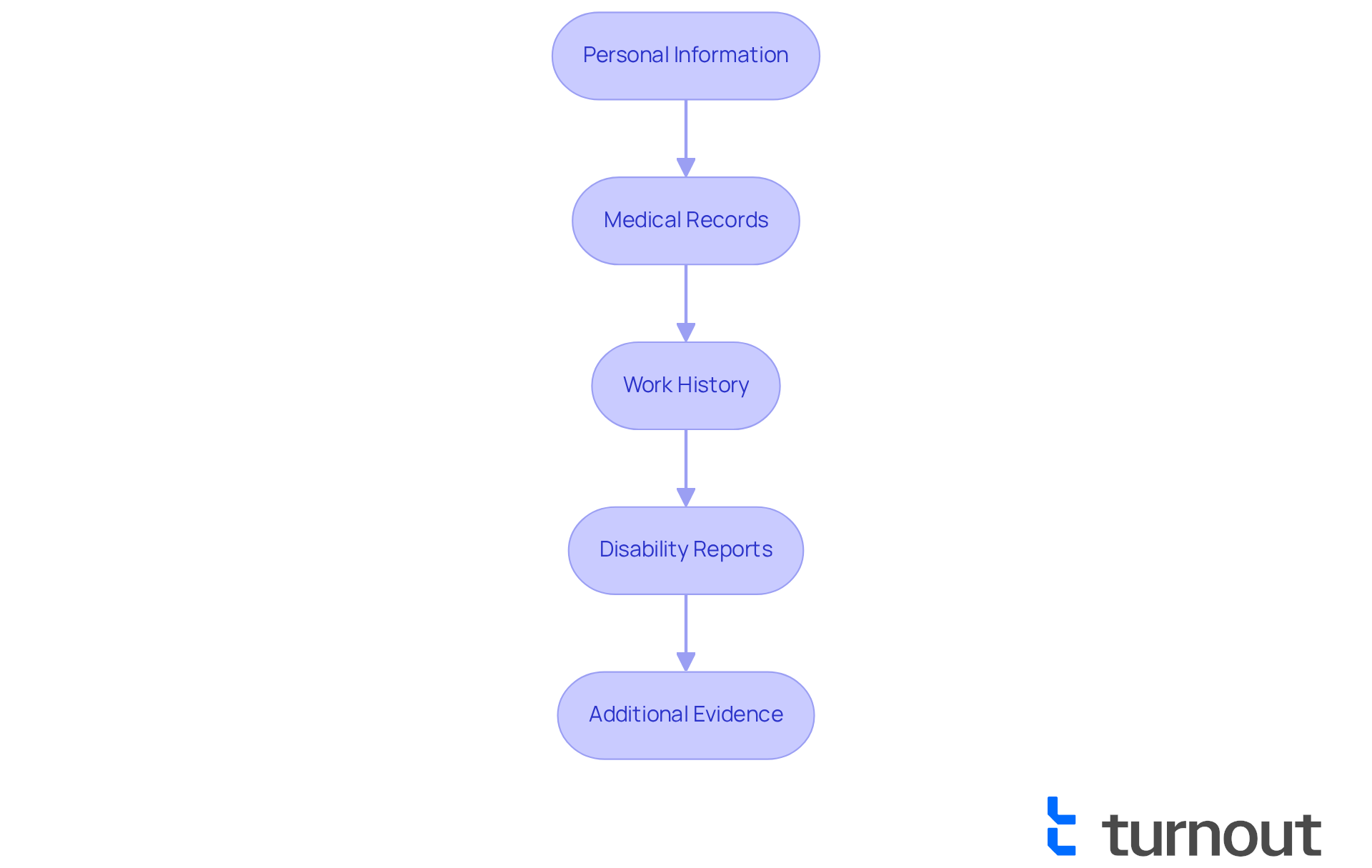
Complete Your SSDI Application Accurately
Completing your ssdi filing accurately can feel overwhelming, but we're here to help you through it. Taking the right steps can make a significant difference in your journey toward ssdi filing and obtaining the support you need.
-
Choose Your Application Method: You have options! You can apply online through the SSA website, by phone, or in person at your local SSA office. Many find that online submissions are quicker and more effective, which can ease some of the stress.
-
Fill Out the Application Forms: Start with Form SSA-16 (Application for Disability Insurance Benefits). Be thorough and honest in your responses. Share as much detail as you can about your medical condition and work history. Remember, this is your chance to tell your story.
-
Review Your Information: It’s common to feel anxious about making mistakes. Take a moment to double-check all entries for accuracy. Ensure that your Social Security number, contact information, and medical details are correct. This step is crucial for ensuring a smooth ssdi filing process.
-
Submit Your Request: Once you’ve completed the forms, it’s time to submit your request. If you’re applying online, follow the prompts carefully to ensure everything goes through successfully.
-
Keep Copies: Create duplicates of your finished submission and all supporting materials for your records. This will be helpful if you need to reference them later. Keeping organized can alleviate some worries.
Taking the time to correctly fill out your ssdi filing can significantly enhance your chances of approval. Remember, you are not alone in this journey, and every step you take brings you closer to the support you deserve.
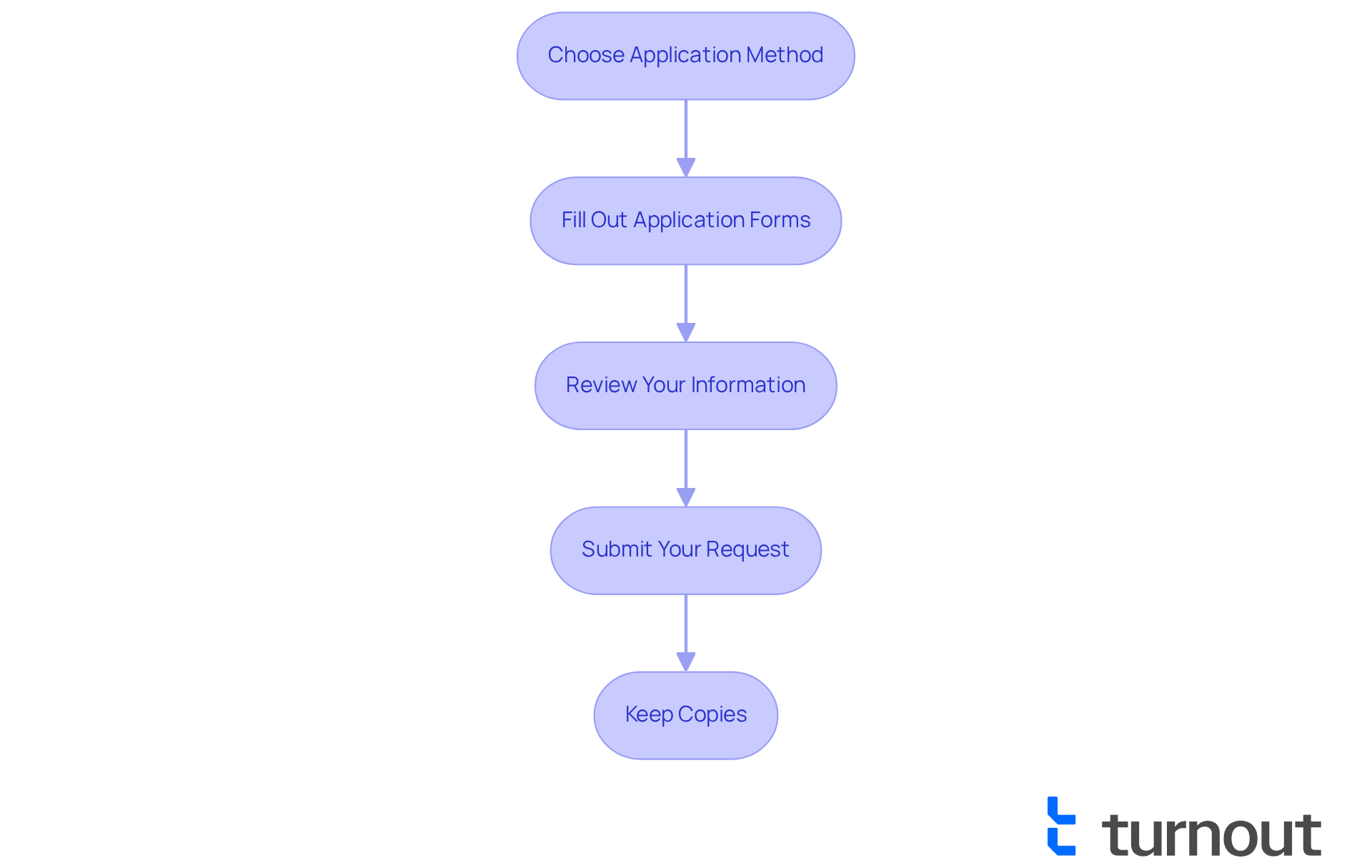
Understand the SSA Review Process and Possible Outcomes
After submitting your ssdi filing, it will be evaluated by the SSA. Here’s what you can expect:
- Initial Review: The SSA will first check your submission for completeness and accuracy. They may reach out for additional information if needed.
- Medical Review: Your medical records will be evaluated by a claims examiner, who will determine if your condition meets the SSA's definition of disability.
- Decision Timeline: The evaluation period can last from 3 to 5 months. During this time, you can check the status of your application online.
- Possible Outcomes: You may receive one of three decisions:
- Approved: You will receive a notice of award detailing your benefits.
- Denied: If denied, the notice will explain the reasons for the decision.
- Request for More Information: Sometimes, the SSA may need additional documentation before making a decision.
We understand that navigating the ssdi filing process can be overwhelming. Comprehending these steps can help you prepare for what’s next, whether that means celebrating a confirmation or gearing up for a challenge. At Turnout, we’re here to support you through this intricate procedure. Our skilled nonlegal advocates can assist you in getting the help you need without the necessity of legal representation. Remember, Turnout is not a law firm, and the assistance provided does not constitute legal advice. You are not alone in this journey.
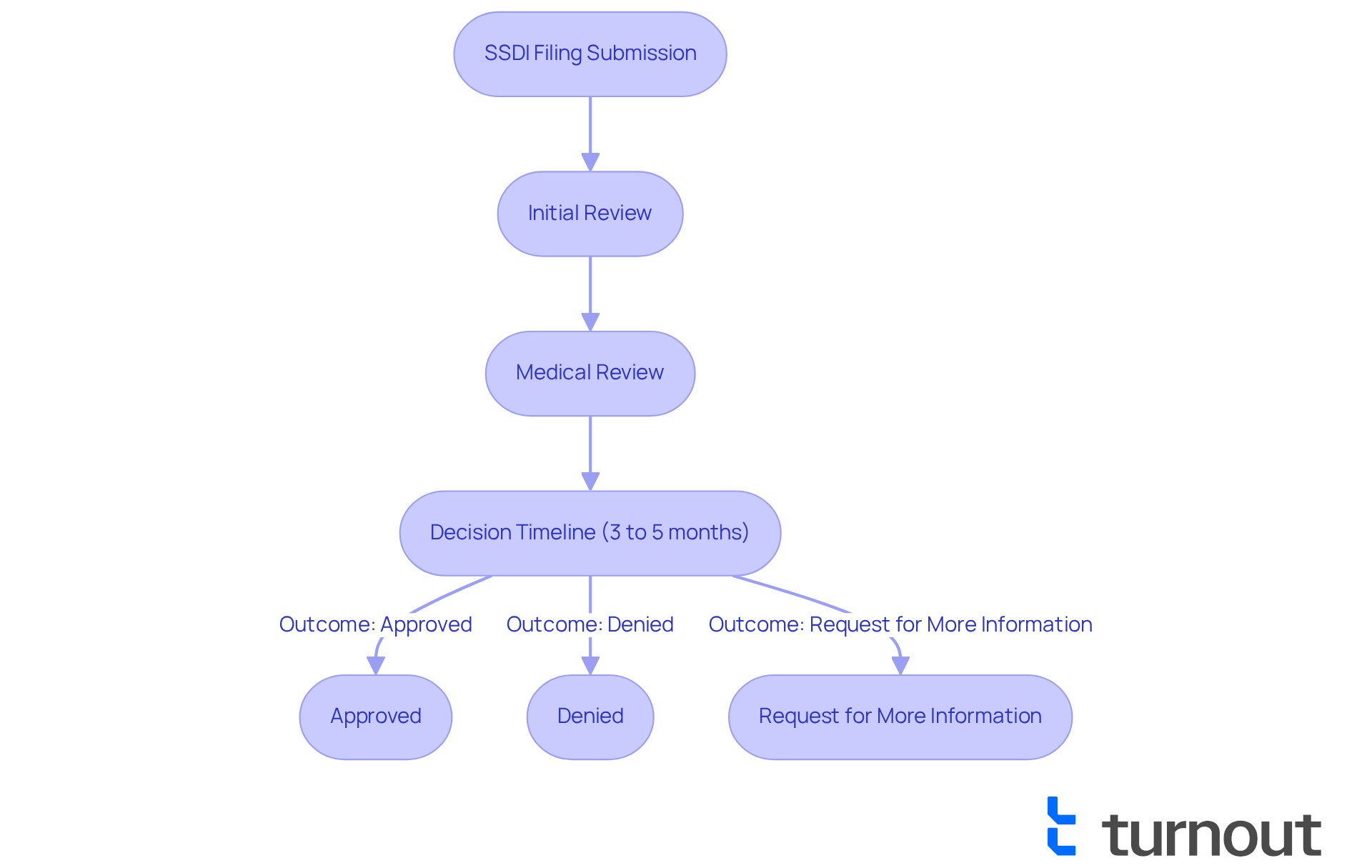
Navigate the Appeals Process if Your Claim is Denied
If your SSDI filing is denied, don’t lose hope. You have the right to appeal the decision related to your SSDI filing, and we’re here to help you through this process. Here’s how to navigate the appeals journey with the support of Turnout:
-
Understand the Denial: Take a moment to carefully read the denial letter. Understanding the reasons behind the decision is crucial. This knowledge will empower you to address specific issues in your SSDI filing appeal.
-
File your SSDI filing appeal promptly: Remember, you have 60 days from the date of the denial letter to file your appeal. Use Form SSA-561 (Request for Reconsideration) to kick off the process. You can even start your appeal online, making it easier for you.
-
Gather additional evidence to strengthen your case for SSDI filing by collecting new medical documentation or other supporting evidence. This could include updated medical records or additional statements from healthcare providers. Including compelling evidence from outside authorities, like employer letters or specialist evaluations, can significantly influence the reconsideration of your claim.
-
Submit Your Appeal: Complete the appeal form and submit it along with any new evidence. Make sure to keep copies of everything you send. It’s important to note that only about 15% of SSDI filing claims are approved after reconsideration, but the approval rate jumps to nearly 45% after a hearing before an Administrative Law Judge (ALJ). Comprehensive preparation is essential, and Turnout's trained nonlegal advocates can support you in this undertaking.
-
Prepare for a Hearing: If your appeal is denied again, you can request a hearing before an ALJ. Be prepared for a wait of 8 to 24 months for your hearing date. Review your case file and gather all relevant evidence to present your case effectively. If your benefits are ended, you may keep receiving them during the appeal stage by signing and returning Form SSA-795 within ten days of the termination notice.
Navigating the appeals process for SSDI filing can be challenging, but with Turnout's support and thorough preparation, you can enhance your chances of a successful outcome. Approval rates improve significantly at the hearing stage, with nearly 57% of cases resulting in a favorable decision when adequately prepared. Remember, you are not alone in this journey.
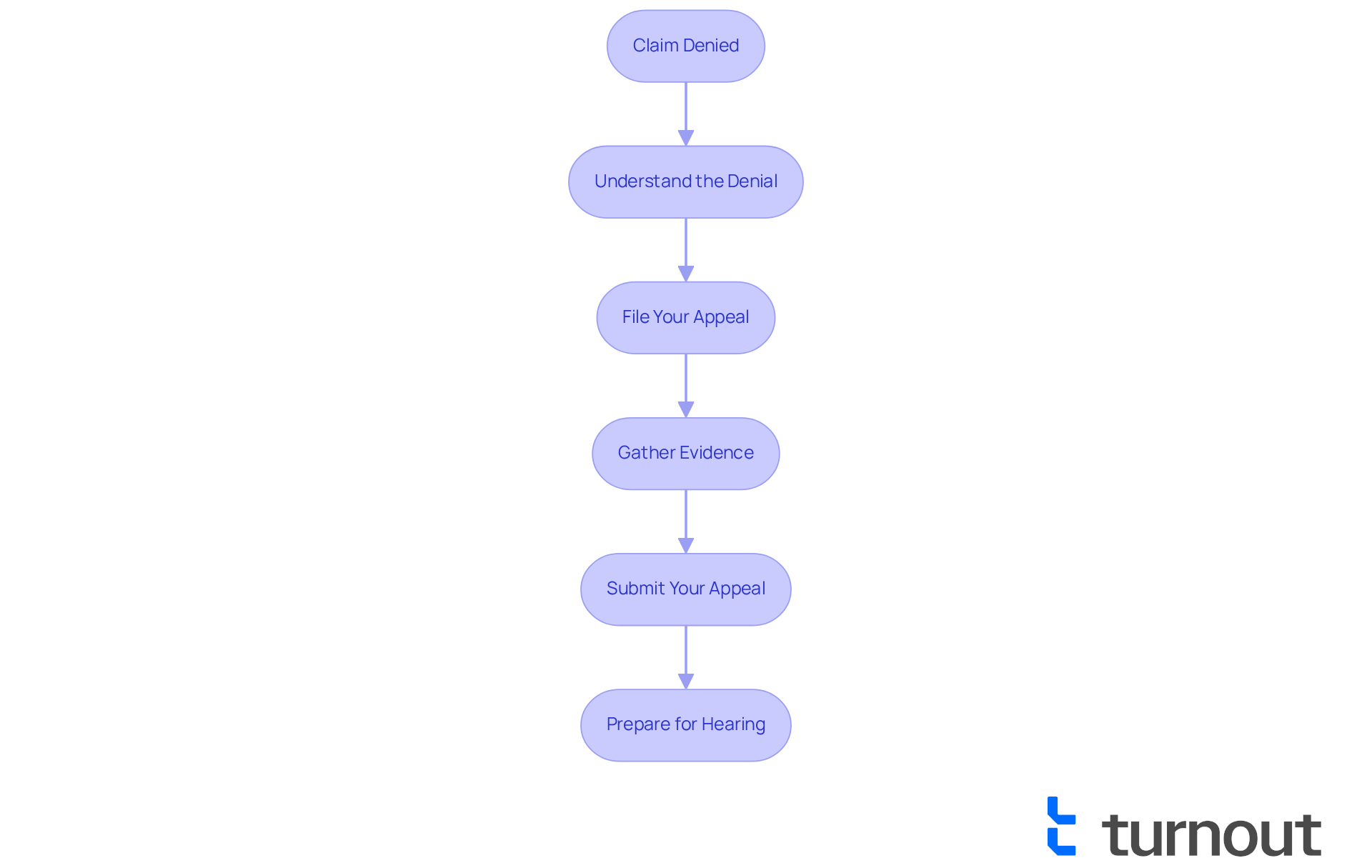
Conclusion
Navigating the SSDI filing process can feel overwhelming, but you’re not alone. Understanding the essential steps can empower you to secure the support you need. This guide has illuminated the path from:
- Determining eligibility
- Gathering necessary documentation
- Accurately completing the application
- Understanding the review process
Each step is crucial in presenting a strong case for your claims.
We understand that meeting eligibility criteria and gathering comprehensive documentation can be challenging. It’s vital to ensure accuracy in your application. Additionally, this guide has provided valuable insights into the SSA review process and the appeals procedure in case of denial. With the right preparation and support, you can significantly increase your chances of a successful outcome.
Ultimately, the SSDI filing journey doesn’t have to be faced alone. Utilizing available resources, such as advocacy services, can make a substantial difference. Staying informed and proactive throughout the process is essential, as it can lead to securing the benefits needed to improve your quality of life. Taking that first step towards filing for SSDI is a courageous move, and with the right guidance, it can lead to a favorable resolution. Remember, we’re here to help you every step of the way.
Frequently Asked Questions
What are the eligibility requirements for SSDI filing?
To qualify for SSDI, you generally need to have earned 40 work credits, with 20 of those earned in the last 10 years. You must also have a medical condition that meets the SSA's definition of disability, which prevents you from engaging in substantial gainful activity for at least 12 months.
How is eligibility affected by age?
If you are under 24, the work credit requirements may be less stringent. However, older applicants, particularly those over 50, may face stricter eligibility assessments due to proposed changes in the disability benefits criteria.
What type of medical evidence is required for SSDI claims?
You need comprehensive medical documentation, including records from healthcare providers detailing your diagnosis, treatment history, and any limitations your condition imposes on daily activities. This evidence is crucial for supporting your claim.
How can I check my eligibility for SSDI?
You can use the SSA's online tools to check your eligibility or consult with a knowledgeable advocate from Turnout, who can guide you through the process. Turnout employs trained non-legal advocates to assist with SSDI filing.
What personal information do I need to gather for my SSDI application?
You need to collect your Social Security number, birth certificate, and proof of U.S. citizenship or lawful alien status.
What documentation is required regarding work history?
You should prepare a list of your jobs for the past 15 years, including employer names, job titles, and dates of employment. You may also need W-2 forms or pay stubs to verify your earnings.
What forms do I need to complete for my SSDI application?
You must complete the Adult Disability Report (Form SSA-3368) and any other relevant forms that detail how your disability affects your daily life.
What additional evidence can support my SSDI claim?
You can collect statements from family or friends about how your condition impacts your ability to work, and a written statement from your doctor outlining your condition and its restrictions can enhance your case.
What is the approval rate for SSDI claims?
The approval rate for SSDI claims has recently declined, averaging only 36 percent, with roughly 78% of disability benefits requests being denied annually, often due to submission issues rather than the individual's disability condition.
How can I improve my chances of SSDI approval?
Ensuring that your documentation is comprehensive, consistent, and well-organized can significantly improve your chances of approval.




